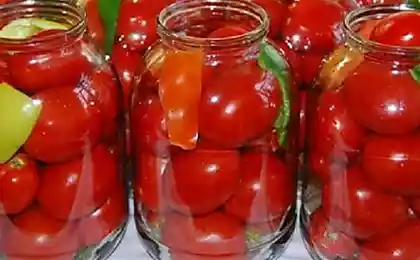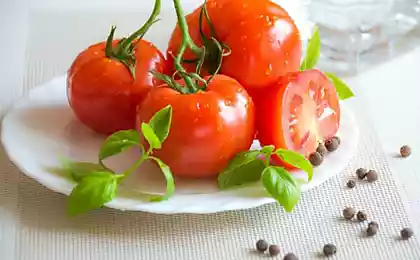594
Why store-bought tomatoes "cardboard" taste
Modern store-bought tomatoes are not too good. Buyers call them "cardboard" (and perhaps not without reason). Often you can even hear the opinion that these taste a tomato gene required modifications. But this is incorrect. Today you will not find in the sale of genetically modified tomatoes, and all these store-bought tasteless tomatoes — natural nowhere that is produced by traditional breeding. Meanwhile, things could be different. Our lives would be a little tastier if the society has made its choice in favor of "cardboard".

The main problem when growing tomatoes, oddly enough, it's their maturation. Simultaneously with maturation, redness, formation of flavor substances begin to happen processes, leading to deterioration of the product. The flesh becomes soft, the tomatoes simply burst, losing marketability and creating a breeding ground for mold and other microorganisms. This is the natural course of things, so nature invented to spread in time the process of "ripening" and "damage" is impossible.
So today in the shops we see the same "unripe" fruits, whose taste is sacrificed for outward appearance and shelf life, as breeders, bringing the most maturation varieties, were forced to destroy their taste. Why spoil the tomatoes?
The fact is that while maturation is the synthesis of the enzyme, which is called polygalacturonate. This enzyme breaks the pectin in the cell walls of the tomato, which leads to softening, breaking the mold, and all the other unpleasant consequences (to the plant it is necessary to scatter seeds).
A little biochemistry. Thus, to make the tomato and delicious, and maturation, it is necessary to reduce the concentration poligalakturonaz, and not changing any other properties. At first glance it seems that this is impossible. However, it is worth remembering how the mechanism of protein synthesis in the cell.
First, information about the structure of the protein is read from the DNA in a chain of messenger RNA, abbreviated mRNA. This information can then in ribosomes is in the finished protein, in our case, the molecule of polygalacturonase. Theoretically reduce the concentration of the enzyme in the cells of the tomato can intervene at any stage in the synthesis process.
But it is not so simple. In a living cell simultaneously runs multiple processes, and not to disturb the vital functions of the body, any interference should be very careful point and the most selective. We can't afford to just regulate protein synthesis, we must regulate the synthesis of very specific protein.
There is a way. To this end the DNA is inserted into a new gene. But not simple, but special. RNA read from the gene, complementary to the original, which is synthesized polygalacturonase. RNA of this type is often called "antisense".
It is able to selectively form a complex with the source, her complementary RNA, reducing its concentration. As a consequence, the rate of synthesis of the enzyme is very much reduced. Manipulation of this kind is selective and does not disrupt the progress of other processes in the cell. So, allow you to change the desired characteristics of the plant without affecting the others.
Contain GMOs. In 1988, this method was used by a group of researchers from the University of Nottingham (UK). Together with scientists from the British company Zeneca Seeds they managed by inserting the "antisense" gene to be significantly reduced tomato sauce concentration polygalacturonase and thereby achieve the extension of the time interval between time of maturation and loss presentation. A little later almost in the same method (with slight differences) the California company Calgene received a similar variety of tomato Flavr Savr (pronounced " flavor saver, "preserving the flavor").
This variety was developed in the UK, where there are restrictions on the cultivation of GM plants, so their production was established in the United States. But in the United Kingdom, they still fell, but this time in the form of imported tomato puree (to permit the sale of raw tomatoes at that time, the creators failed).
Tomato paste under the brands of supermarkets Safeway and Sainsbury's appeared on the shelves in early 1996. Not to say that it was a sensation. But it was a success. Losses at harvest and processing declined, and the new product was cheaper than traditional tomato paste. The flesh of the new variety was richer in dry matter and pectin than traditional varieties, so the puree was 80% more viscous.
And, of course, much more palatable. Sales were very active, many shops ahead of the indicators of "natural" competitor. But the most incredible was that every Bank in the most prominent place was adorned with the inscription: "Made from genetically modified tomatoes", although according to the laws of that time it was not necessarily. And one of the buyers, this message is not frightened, but quite the contrary.
The focus of discussion. There were no signs of trouble. But producers of tomato puree did not know that the famous geneticist Professor Arpad Pusztai in 1995 he started to work on assessing the safety of one variety of GM potato, in which was inserted the gene responsible for the synthesis of a poisonous lectin the snowdrop. And nobody could predict that this study — or rather the public outcry around it, permanently shut down the road to many good beginnings.
The security check is standard procedure for any GM plants. If for some reason a new GMO will be harmful, it is the protection from getting it on the market and guarantee the degree of security, which can not boast of any one of the selection grade. Even if not to take into account the inconsistency of the conclusions from the work Pusztai (he was two weeks fed GM potatoes with a poisonous lectin granivorous rats, normal diet was potatoes, and then made a conclusion about the dangers of potatoes to rats, or lectin, or even specific varieties of GM potatoes for mammals, and about the dangers of GMOs in General), there is nothing extraordinary, in fact, did not happen.
More precisely, would not have happened if the focus of the discussions has not shifted, as it often happens, from the science in society (and regardless of whether it was potatoes harmful actually). But society is not always capable of making decisions guided by facts, not emotions. As defenders of consumers, unfortunately, are most often not the most intelligent representatives of humanity and almost always — not even versed in the basic principles of what they are fighting.
Black PR. The beginning of 1999 was marked in the UK (and not only) daily shows and publications in the media about the dangers of GMOs (something similar can be observed in our country). In 1999, according to the polls, the calm and considered attitude of Europeans towards GMOs gave way to negative until irreconcilable.
It was then, after only three years, after such a promising debut, instead of going on to Europe and maybe to get to us, disappeared from the shelves of the UK's first puree from GM tomatoes. Disappeared, never to appear again. Along with the puree was gone and maturation delicious tomatoes. And unlikely to return. The cost of the procedure safety checks, given the established negative image of GMOs does manufacture such a product is simply unprofitable.
We often hear that corporations in collusion with government, not give the consumer a choice, feed us all GMO and pesticides. But in fact, the ones who complain about corporations and collusion, made it so that the store did not become a tasty tomato. Who knows how many delicious foods we have today are their efforts?
How to fix a broken.Many of you probably noticed that the tomatoes my grandmother," with a characteristic green nedozrelye" around the stalk, are tastier than store uniformly red fruit. But GMOs are nothing to do with it. Just "beef" tomatoes are too perishable, so store do not sell them. You already know how the scientists managed to make a non-perishable tomatoes. But "NewConnect" modern store tomatoes is due to quite other causes.
The fact that photosynthesis in tomatoes regulate the two gene GLK1 and GLK2. Their functions overlap, and the failure of any of them leads to serious disturbances in the physiology of plants. In the leaves of both genes. In maturing fruits only GLK2. His activity in the area of the stem is higher, which leads to uneven ripening, when half of the fruit is red, and the top is still green.
But over the last 70 years, the efforts of breeders have been aimed at removing the "beautiful" varieties of tomatoes, the fruits of which are painted evenly: presentation, "uniform " maturity" is important for mass production. And once in the course of selection the gene GLK2 "broke". Such plants viable.
Fruits of tomato with a non-working gene are painted evenly, and the beautiful varieties with this symptom quickly captured the stalls and fields. However, in the fruit stop the photosynthesis, they became less sugars and aromatic substances: tomato lost its real taste.
Recently, a group of scientists from several universities — American (UC Davis, Cornell and Michigan), Spanish (Valencia and Malaga) and the Argentine National University of La Plata — "built" into the genome of the tomato working version of the corrupted when gene GLK2 and "launched" it. But not only in the region of the stalk and evenly throughout the fruit. The results exceeded all expectations: the new tomatoes were delicious, and the uniformity of the color remained.
However, let's be honest: we are not sure that the tomatoes were really delicious, since the conclusions about the taste obtained as a result of the tasting, but only by chemical analysis. The reason for that strict rules: taste test samples is impossible until then, until proven their safety. And even the developers themselves say that have not tried them. Let's pretend that we believe them.
But it is very significant that genetic engineering can correct (and improve) what one messed up selection. Perhaps when it does established us unfounded fears around genetic technologies, customers will be able to see a really tasty fruit in stores and not just on the pages of scientific periodicals.
The legend of ibopamine. Among the many stories about GMOs, obtained by shuffling the genes of different organisms, a popular legend of the frost-resistant tomatoes in DNA which is the gene of a flounder. I'm sorry to disappoint both supporters of GMOs and opponents, but it's just a story — these tomatoes do not exist in nature. But the element of truth in this story.
The idea is simple and lies on the surface. Many fish that live in cold water, do synthesize proteins, preventing crystallization of the water in the cells. More precisely, inhibiting growth of ice crystals that can destroy cells or harm the organelles. If we can teach a plant to synthesize this "antifreeze" protein in the tissues, it is theoretically possible to create not only winter potatoes, but also, say, tomatoes, which can withstand deep freezing and defrosting, without loss of marketable appearance and taste.
Alas, to date, no "tomato with a flounder gene" will not buy. But protein-antifreeze (apart from fish) can be purchased, it is produced using genetically modified yeast. By the way, this protein (harmless to health) in some countries it is allowed to add, for example, ice cream is a very small addition (less than 0.01%) significantly increases the consumer qualities of the product. After all, the smaller the ice crystals, the better and sweeter the flavour of ice cream.
In General, no flounder genes, and human genes, bacteria or oak does not exist. There are genes responsible for the synthesis of a specific protein. It is for specific proteins and scientists engaged in the incorporation of certain genes in the process of creating GMOs.
istochnikami
Source: /users/1077

The main problem when growing tomatoes, oddly enough, it's their maturation. Simultaneously with maturation, redness, formation of flavor substances begin to happen processes, leading to deterioration of the product. The flesh becomes soft, the tomatoes simply burst, losing marketability and creating a breeding ground for mold and other microorganisms. This is the natural course of things, so nature invented to spread in time the process of "ripening" and "damage" is impossible.
So today in the shops we see the same "unripe" fruits, whose taste is sacrificed for outward appearance and shelf life, as breeders, bringing the most maturation varieties, were forced to destroy their taste. Why spoil the tomatoes?
The fact is that while maturation is the synthesis of the enzyme, which is called polygalacturonate. This enzyme breaks the pectin in the cell walls of the tomato, which leads to softening, breaking the mold, and all the other unpleasant consequences (to the plant it is necessary to scatter seeds).
A little biochemistry. Thus, to make the tomato and delicious, and maturation, it is necessary to reduce the concentration poligalakturonaz, and not changing any other properties. At first glance it seems that this is impossible. However, it is worth remembering how the mechanism of protein synthesis in the cell.
First, information about the structure of the protein is read from the DNA in a chain of messenger RNA, abbreviated mRNA. This information can then in ribosomes is in the finished protein, in our case, the molecule of polygalacturonase. Theoretically reduce the concentration of the enzyme in the cells of the tomato can intervene at any stage in the synthesis process.
But it is not so simple. In a living cell simultaneously runs multiple processes, and not to disturb the vital functions of the body, any interference should be very careful point and the most selective. We can't afford to just regulate protein synthesis, we must regulate the synthesis of very specific protein.
There is a way. To this end the DNA is inserted into a new gene. But not simple, but special. RNA read from the gene, complementary to the original, which is synthesized polygalacturonase. RNA of this type is often called "antisense".
It is able to selectively form a complex with the source, her complementary RNA, reducing its concentration. As a consequence, the rate of synthesis of the enzyme is very much reduced. Manipulation of this kind is selective and does not disrupt the progress of other processes in the cell. So, allow you to change the desired characteristics of the plant without affecting the others.
Contain GMOs. In 1988, this method was used by a group of researchers from the University of Nottingham (UK). Together with scientists from the British company Zeneca Seeds they managed by inserting the "antisense" gene to be significantly reduced tomato sauce concentration polygalacturonase and thereby achieve the extension of the time interval between time of maturation and loss presentation. A little later almost in the same method (with slight differences) the California company Calgene received a similar variety of tomato Flavr Savr (pronounced " flavor saver, "preserving the flavor").
This variety was developed in the UK, where there are restrictions on the cultivation of GM plants, so their production was established in the United States. But in the United Kingdom, they still fell, but this time in the form of imported tomato puree (to permit the sale of raw tomatoes at that time, the creators failed).
Tomato paste under the brands of supermarkets Safeway and Sainsbury's appeared on the shelves in early 1996. Not to say that it was a sensation. But it was a success. Losses at harvest and processing declined, and the new product was cheaper than traditional tomato paste. The flesh of the new variety was richer in dry matter and pectin than traditional varieties, so the puree was 80% more viscous.
And, of course, much more palatable. Sales were very active, many shops ahead of the indicators of "natural" competitor. But the most incredible was that every Bank in the most prominent place was adorned with the inscription: "Made from genetically modified tomatoes", although according to the laws of that time it was not necessarily. And one of the buyers, this message is not frightened, but quite the contrary.
The focus of discussion. There were no signs of trouble. But producers of tomato puree did not know that the famous geneticist Professor Arpad Pusztai in 1995 he started to work on assessing the safety of one variety of GM potato, in which was inserted the gene responsible for the synthesis of a poisonous lectin the snowdrop. And nobody could predict that this study — or rather the public outcry around it, permanently shut down the road to many good beginnings.
The security check is standard procedure for any GM plants. If for some reason a new GMO will be harmful, it is the protection from getting it on the market and guarantee the degree of security, which can not boast of any one of the selection grade. Even if not to take into account the inconsistency of the conclusions from the work Pusztai (he was two weeks fed GM potatoes with a poisonous lectin granivorous rats, normal diet was potatoes, and then made a conclusion about the dangers of potatoes to rats, or lectin, or even specific varieties of GM potatoes for mammals, and about the dangers of GMOs in General), there is nothing extraordinary, in fact, did not happen.
More precisely, would not have happened if the focus of the discussions has not shifted, as it often happens, from the science in society (and regardless of whether it was potatoes harmful actually). But society is not always capable of making decisions guided by facts, not emotions. As defenders of consumers, unfortunately, are most often not the most intelligent representatives of humanity and almost always — not even versed in the basic principles of what they are fighting.
Black PR. The beginning of 1999 was marked in the UK (and not only) daily shows and publications in the media about the dangers of GMOs (something similar can be observed in our country). In 1999, according to the polls, the calm and considered attitude of Europeans towards GMOs gave way to negative until irreconcilable.
It was then, after only three years, after such a promising debut, instead of going on to Europe and maybe to get to us, disappeared from the shelves of the UK's first puree from GM tomatoes. Disappeared, never to appear again. Along with the puree was gone and maturation delicious tomatoes. And unlikely to return. The cost of the procedure safety checks, given the established negative image of GMOs does manufacture such a product is simply unprofitable.
We often hear that corporations in collusion with government, not give the consumer a choice, feed us all GMO and pesticides. But in fact, the ones who complain about corporations and collusion, made it so that the store did not become a tasty tomato. Who knows how many delicious foods we have today are their efforts?
How to fix a broken.Many of you probably noticed that the tomatoes my grandmother," with a characteristic green nedozrelye" around the stalk, are tastier than store uniformly red fruit. But GMOs are nothing to do with it. Just "beef" tomatoes are too perishable, so store do not sell them. You already know how the scientists managed to make a non-perishable tomatoes. But "NewConnect" modern store tomatoes is due to quite other causes.
The fact that photosynthesis in tomatoes regulate the two gene GLK1 and GLK2. Their functions overlap, and the failure of any of them leads to serious disturbances in the physiology of plants. In the leaves of both genes. In maturing fruits only GLK2. His activity in the area of the stem is higher, which leads to uneven ripening, when half of the fruit is red, and the top is still green.
But over the last 70 years, the efforts of breeders have been aimed at removing the "beautiful" varieties of tomatoes, the fruits of which are painted evenly: presentation, "uniform " maturity" is important for mass production. And once in the course of selection the gene GLK2 "broke". Such plants viable.
Fruits of tomato with a non-working gene are painted evenly, and the beautiful varieties with this symptom quickly captured the stalls and fields. However, in the fruit stop the photosynthesis, they became less sugars and aromatic substances: tomato lost its real taste.
Recently, a group of scientists from several universities — American (UC Davis, Cornell and Michigan), Spanish (Valencia and Malaga) and the Argentine National University of La Plata — "built" into the genome of the tomato working version of the corrupted when gene GLK2 and "launched" it. But not only in the region of the stalk and evenly throughout the fruit. The results exceeded all expectations: the new tomatoes were delicious, and the uniformity of the color remained.
However, let's be honest: we are not sure that the tomatoes were really delicious, since the conclusions about the taste obtained as a result of the tasting, but only by chemical analysis. The reason for that strict rules: taste test samples is impossible until then, until proven their safety. And even the developers themselves say that have not tried them. Let's pretend that we believe them.
But it is very significant that genetic engineering can correct (and improve) what one messed up selection. Perhaps when it does established us unfounded fears around genetic technologies, customers will be able to see a really tasty fruit in stores and not just on the pages of scientific periodicals.
The legend of ibopamine. Among the many stories about GMOs, obtained by shuffling the genes of different organisms, a popular legend of the frost-resistant tomatoes in DNA which is the gene of a flounder. I'm sorry to disappoint both supporters of GMOs and opponents, but it's just a story — these tomatoes do not exist in nature. But the element of truth in this story.
The idea is simple and lies on the surface. Many fish that live in cold water, do synthesize proteins, preventing crystallization of the water in the cells. More precisely, inhibiting growth of ice crystals that can destroy cells or harm the organelles. If we can teach a plant to synthesize this "antifreeze" protein in the tissues, it is theoretically possible to create not only winter potatoes, but also, say, tomatoes, which can withstand deep freezing and defrosting, without loss of marketable appearance and taste.
Alas, to date, no "tomato with a flounder gene" will not buy. But protein-antifreeze (apart from fish) can be purchased, it is produced using genetically modified yeast. By the way, this protein (harmless to health) in some countries it is allowed to add, for example, ice cream is a very small addition (less than 0.01%) significantly increases the consumer qualities of the product. After all, the smaller the ice crystals, the better and sweeter the flavour of ice cream.
In General, no flounder genes, and human genes, bacteria or oak does not exist. There are genes responsible for the synthesis of a specific protein. It is for specific proteins and scientists engaged in the incorporation of certain genes in the process of creating GMOs.
istochnikami
Source: /users/1077
As North Korea has achieved unprecedented growth of agriculture
The history of the main van of the Soviet Union






















